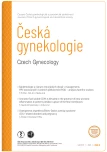Endometriosis in postmenopause
Authors:
J. Hanáček 1,2
; J. Drahoňovský 1,2; Hynek Heřman 1,2
; M. Eminger 1; P. Křepelka 1,2
; P. Velebil 1,2; K. Macková 1,2
; M. Dibonová 3,4
Authors place of work:
Ústav pro péči o matku a dítě, Praha
1; 3. lékařská fakulta UK, Praha
2; Porodnicko-gynekologická klinika LF UP a FN Olomouc
3; Gynekologicko-porodnické oddělení, Nemocnice ve Frýdku-Místku, p. o.
4
Published in the journal:
Ceska Gynekol 2022; 87(6): 427-431
Category:
Přehledový článek
doi:
https://doi.org/10.48095/cccg2022427
Summary
In our review article, we focused on the rare topic of endometriosis in postmenopause. Endometriosis is primarily a disease of women of reproductive age. In postmenopause, atrophy of endometriosis foci usually occurs. However, recurrence or even de novo occurrence of endometriosis in postmenopause has also been described. The prevalence in postmenopause has been reported to be around 2–5%. Factors that may account for the recurrence of endometriosis are exogenously administered estrogens, self-production of estrogens in peripheral adipose tissue, or activation of aromatase in the focus of endometriosis. When hormonal therapy is required, the best results are achieved by administration of Tibolone. Risk factors for recurrence and subsequent difficulties are the extent of endometriosis, the retained uterus and adnexa. Pain was the most common symptom in 43.5% and palpable finding in 28%. Endometriotic cells are capable of proliferation, survival in an ectopic localization and metastasis to distant locations. The risk of malignant transformation is around 1% and the most common are ovarian tumors. Endometriosis-associated ovarian tumors are typically low-grade disease, histologically endometrioid or clear cell carcinomas. Diagnosis is based on ultrasound and magnetic resonance imaging. The basis of therapy for newly developed endometriosis or when symptoms associated with the risk of endometriosis appear is a surgical solution, primarily to exclude the cancerous process.
Keywords:
Endometriosis – malignancy – postmenopause – hormonal treatment
Zdroje
1. Rosa-e-Silva JC, Carvalho BR, de F Barbosa H et al. Endometriosis in postmenopausal women without previous hormonal therapy: report of three cases. Climacteric 2008; 11 (6): 525–528. doi: 10.1080/13697130802490256.
2. Morotti M, Remorgida V, Venturini PL et al. Endometriosis in menopause: a single institution experience. Arch Gynecol Obstet 2012; 286 (6): 1571–1575. doi: 10.1007/s00404-012-24 73-5.
3. Punnonen R, Klemi PJ, Nikkanen V. Postmenopausal endometriosis. Eur J Obstet Gynecol Reprod Biol 1980; 11 (3): 195–200. doi: 10.1016/0028-2243 (80) 90069-6.
4. Bulun SE. Endometriosis. N Engl J Med 2009; 360 (3): 268–279. doi: 10.1056/NEJMra0804690.
5. Henriksen E. Endometriosis. Am J Surg 1955; 90 (2): 331–337. doi: 10.1016/0002-9610 (55) 90765-0.
6. Haas D, Chvatal R, Reichert B et al. Endometriosis: a premenopausal disease? Age pattern in 42,079 patients with endometriosis. Arch Gynecol Obstet 2012; 286 (3): 667–670. doi: 10.1007/s00404-012-2361-z.
7. Bulun SE, Gurates B, Fang Z et al. Mechanisms of excessive estrogen formation in endometriosis. J Reprod Immunol 2002; 55 (1–2): 21–33. doi: 10.1016/s0165-0378 (01) 00132-2.
8. Streuli I, Gaitzsch H, Wenger JM et al. Endometriosis after menopause: physiopathology and management of an uncommon condition. Climacteric 2017; 20 (2): 138–143. doi: 10.1080/13697137.2017.1284781.
9. Toki T, Horiuchi A, Li SF et al. Proliferative activity of postmenopausal endometriosis: a histopathologic and immunocytochemical study. Int J Gynecol Pathol 1996; 15 (1): 45–53. doi: 10.1097/00004347-199601000-00008.
10. Vignali M, Bianchi S, Candiani M et al. Surgical treatment of deep endometriosis and risk of recurrence. J Minim Invasive Gynecol 2005; 12 (6): 508–513. doi: 10.1016/j.jmig.2005.06. 016.
11. Pollacco J, Sacco K, Portelli M et al. Molecular links between endometriosis and cancer. Gynecol Endocrinol 2012; 28 (8): 577–581. doi: 10.3109/09513590.2011.650761.
12. Pearce CL, Templeman C, Rossing MA et al. Association between endometriosis and risk of histological subtypes of ovarian cancer: a pooled analysis of case-control studies. Lancet Oncol 2012 13 (4): 385–394. doi: 10.1016/S1470- 2045 (11) 70404-1.
13. Gemmell LC, Webster KE, Kirtley S et al. The management of menopause in women with a history of endometriosis: a systematic review. Hum Reprod Update 2017; 23 (4): 481–500. doi: 10.1093/humupd/dmx011.
14. Noel JC, Anaf V, Fayt I et al. Ureteral mullerian carcinosarcoma (mixed mullerian tumor) associated with endometriosis occurring in a patient with a concentrated soy isoflavones supplementation. Arch Gynecol Obstet 2006; 274 (6): 389–392. doi: 10.1007/s00404-006-01 88-1.
15. Fedele L, Bianchi S, Raffaelli R et al. Comparison of transdermal estradiol and tibolone for the treatment of oophorectomized women with deep residual endometriosis. Maturitas 1999; 32 (3): 189–193. doi: 10.1016/s0378- 5122 (99) 00032-8.
16. Matorras R, Elorriaga MA, Pijoan JI et al. Recurrence of endometriosis in women with bilateral adnexectomy (with or without total hysterectomy) who received hormone replacement therapy. Fertil Steril 2002; 77 (2): 303–308. doi: 10.1016/s0015-0282 (01) 02981-8.
17. Hickman TN, Namnoum AB, Hinton EL et al. Timing of estrogen replacement therapy following hysterectomy with oophorectomy for endometriosis. Obstet Gynecol 1998; 91 (5 Pt 1): 673–677. doi: 10.1016/s0029-7844 (98) 0 0071-4.
18. Hajjar LR, Kim W, Nolan GH et al. Intestinal and pelvic endometriosis presenting as a tumor and associated with tamoxifen therapy: report of a case. Obstet Gynecol 1993; 82 (4 Pt 2 Suppl): 642–644.
19. Garzetti GG, Ciavattini A, Goteri G et al. Endometrioid carcinoma of the ovary. Retrospective study. Eur J Gynaecol Oncol 1993; 14 (1): 51–55.
20. Takayama K, Zeitoun K, Gunby RT et al. Treatment of severe postmenopausal endometriosis with an aromatase inhibitor. Fertil Steril 1998; 69 (4): 709–713. doi: 10.1016/s0015-0282 (98) 00022-3.
Štítky
Dětská gynekologie Gynekologie a porodnictví Reprodukční medicínaČlánek vyšel v časopise
Česká gynekologie

2022 Číslo 6
- Primární prevence osteoporózy v kostce
- Horní limit denní dávky vitaminu D: Jaké množství je ještě bezpečné?
- Isoprinosin je bezpečný a účinný v léčbě pacientů s akutní respirační virovou infekcí
- Moje zkušenosti s Magnosolvem podávaným pacientům jako profylaxe migrény a u pacientů s diagnostikovanou spazmofilní tetanií i při normomagnezémii - MUDr. Dana Pecharová, neurolog
- Dlouhodobé užívání dienogestu v terapii endometriózy
Nejčtenější v tomto čísle
- Nová kombinovaná perorální antikoncepce obsahující estetrol: přehledový článek evropského panelu odborníků
- Endometrióza v postmenopauze
- Vybrané patologické stavy ovlivňující receptivitu endometria
- Karcinom vulvy a jeho recidivy – zásady operační léčby
